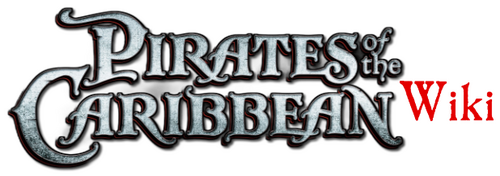- "One of the things I like to do when I'm approaching a project that's offered to me and when I'm trying to figure out whether to do it or not is—for instance—if it's a period piece, is it something that I can bring something to, or is the director trying to simply retell something historically and wanting absolute period accuracy. That doesn't particularly interest me. What I love about 'Pirates' and working with Gore is the fact that the history and period are backdrops, something that gives us a sense of time and place. But everybody is excited to take that to the next level of stylization and reimagining. It's like taking the elements and shaking them up and creating something different out of them."
- ―Rick Heinrichs
An amazing, creative individual,” says Jerry Bruckheimer of Heinrichs. Adds Johnny Depp, “I’ve had the pleasure of working with Rick Heinrichs a number of times now over the years. And boy, oh boy, talk about somebody outdoing themselves. He’s really gone far into the stratosphere and done some monumental work. My initial reaction to much of the sets was…can I get the blueprints? ’Cause I want to build this somewhere and live in it. Rick is a very gifted, talented artist, and we’re super lucky to have him.” “I got excited when I first spoke to Gore,” recalls Heinrichs, “because he was sitting there drawing these images of pirate ships and monsters, saying that he was taking what he had established in the first film to a whole other level of mythology. We’re going to attempt to strike a similar balance in this film of scary and humorous elements, which really goes back to the original theme-park attraction. “Hopefully, people will be going home from this movie with the same kind of excitement that audiences got from the Douglas Fairbanks and Errol Flynn movies in the earlier part of the 20th century…but with the kind of technology that we can bring to bear on it now,” continues Heinrichs. “We’re trying to take the first ‘Pirates’ film to the next step of virtuosity so that we can walk that line between horror and humor that gives you a great sense of tingling excitement.
Richard "Rick" Heinrichs is one of film's most original and innovative visual artists, masterfully creating alternate universes entirely appropriate to his film's stories and settings. He started his career on visual effects on the other world sequence in The Watcher in the Woods, Tim Burton's Hansel and Gretel and Vincent to later work on Alfred Hitchcock Presents and Nutcracker: The Motion Picture. Rick Heinrichs was the production designer of the Pirates of the Caribbean sequels, Dead Man's Chest and At World's End.
Biography[]
Early life and career[]
Graduated from the California Institute of the Arts in Valencia, California, Rick Heinrichs won the Academy Award for his work on Tim Burton's Sleepy Hollow, for which he also won the British Academy of Film and Television Arts (BAFTA) and Art Directors Guild Awards, among others. He received another Oscar nomination and Art Directors Guild Award for his highly imaginative designs for Lemony Snicket's A Series of Unfortunate Events. Dead Man's Chest also brought Heinrichs an Art Directors Guild Award nomination.
The creative collaboration between Heinrichs and Tim Burton dated back to their early studio days at Walt Disney Pictures when the two produced the animated short Vincent and theatrical short Frankenweenie. They later teamed on Burton's first theatrical feature, Pee-Wee's Big Adventure and then Beetlejuice. Heinrichs had already begun his climb up the film career ladder as set designer on Ghostbusters II and Joe Versus the Volcano in 1989 before teaming with his friend in the same capacity on Edward Scissorhands the next year.
In 1992, Heinrichs moved up to art director on Burton's Batman Returns, having previously done that job on Soapdish. He also served that year as visual consultant on Tim Burton's The Nightmare Before Christmas. Later, Heinrichs was production designer on Burton's hit remake of Planet of the Apes.
Heinrichs' other credits as production designer include Hulk, Bedazzled, The Big Lebowski and Fargo. He also worked as art director on Tall Tale and as set designer on The Fisher King.
Pirates of the Caribbean[]
- "I've had the pleasure of working with Rick Heinrichs a number of times now over the years. And boy, oh boy, talk about somebody outdoing themselves. He's really gone far into the stratosphere and done some monumental work. My initial reaction to much of the sets was...can I get the blueprints? 'Cause I want to build this somewhere and live in it. Rick is a very gifted, talented artist, and we're super lucky to have him."
- ―Johnny Depp
Working alongside director Gore Verbinski and producer Jerry Bruckheimer, Rick Heinrichs was the production designer in the back-to-back productions of the second and third Pirates of the Caribbean films, Dead Man's Chest and At World's End. His work on Dead Man's Chest brought him nominations from the Academy Awards, the British Academy of Film and Television Arts (BAFTA) Award, and an Art Directors Guild Award nomination.
The natural locations and sets designed by Heinrichs unleashed his limitless imagination, providing Dead Man's Chest with vastly scaled and richly imaginative backdrops. Not to mention a small fleet of new ships, including a redesigned, rebuilt and fully seaworthy Black Pearl (from the Sunset); the detailed and terrifying Flying Dutchman; and the sleek 18th-century British merchant ship Edinburgh Trader. Heinrichs and his creative team designed a huge range of settings, from a massive swampland built on a Burbank soundstage, to the small but intricate Dead Man's Chest of the film's subtitle. For At World's End, Heinrichs took part in designing the Chinese junks (the Hai Peng and the Empress), building various sets (particularly Singapore and Shipwreck Cove), and more.
PotC Films[]
- Pirates of the Caribbean: Dead Man's Chest - Production Designer
- Pirates of the Caribbean: At World's End - Production Designer
